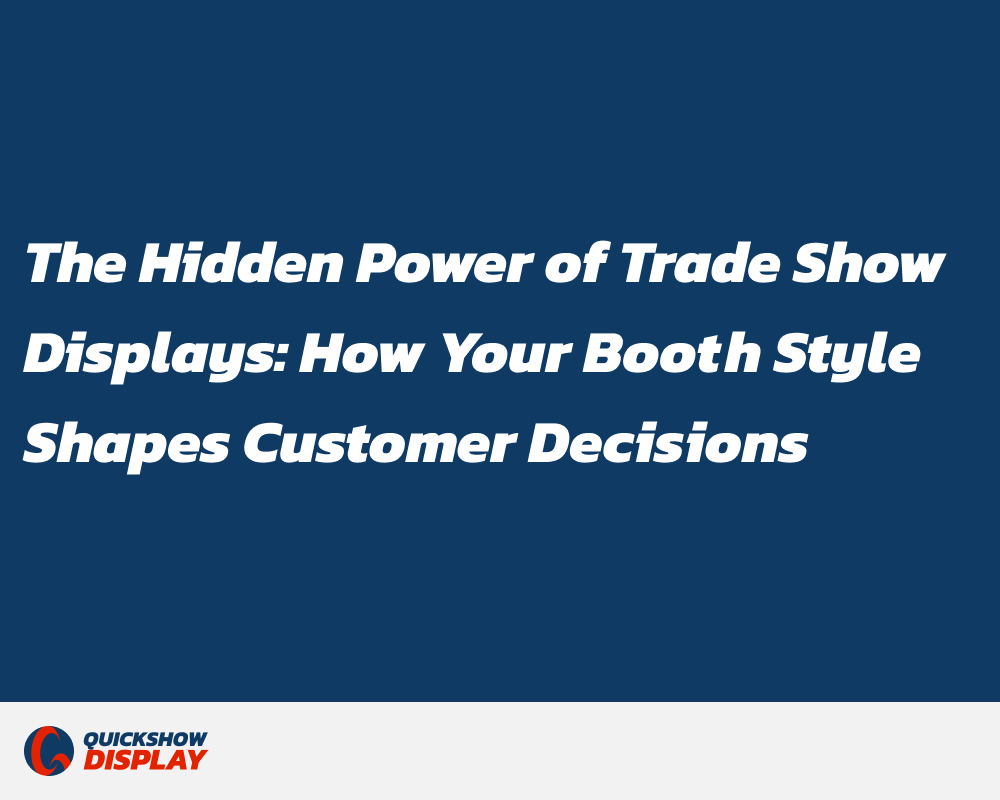The Hidden Power of Trade Show Displays: How Your Booth Style Shapes Customer Decisions

Trade shows are battlegrounds for attention, where your display does more than just showcase products—it silently communicates your brand's story, values, and credibility. While most exhibitors focus on logistics like cost and setup time, few consider how their choice between portable and modular displays subconsciously influences attendee behavior. Understanding this psychological dimension can be the difference between a forgettable booth and one that converts visitors into customers.
1. The Psychology of Space: What Your Booth Size Says About You
Your display's physical footprint sends immediate signals to attendees:
-
Portable displays (pop-ups, banners) create an open, inviting atmosphere that says, "Come chat with us." Their smaller size feels personal and unintimidating, perfect for startups or brands wanting a conversational vibe. Research shows attendees are 40% more likely to approach a booth they perceive as "low-pressure."
-
Modular displays command attention with their larger presence, projecting stability and success. A well-designed modular booth subtly communicates, "We're an industry leader." However, without careful layout planning, they can feel corporate and cold—deterring spontaneous interactions.
Pro Tip: Use modular structures for flagship events but incorporate portable elements (like standing banners) to soften the space and invite approachability.
2. The Memory Game: Why Some Booths Stick in Attendees' Minds
Human brains are wired to remember experiences, not sales pitches. The more sensory cues your booth engages, the longer your brand stays top-of-mind.
-
Portable displays rely heavily on visuals—think bold graphics or a striking backdrop. While effective for quick impressions, they often lack immersive elements that trigger deeper recall.
-
Modular displays excel at creating "memory anchors" through interactive zones, product demos, or lounge areas. A study by Exhibit News Network found that attendees are 3x more likely to remember brands that engage multiple senses (sight, touch, even sound).
Key Insight: Even with a portable display, add a tactile element—like a product sample station—to boost memorability.
3. The Trust Factor: How Design Influences Perceived Credibility
Within seconds, attendees judge your company's professionalism based on your booth's aesthetics.
-
Portable displays risk blending in if they look generic. Custom upgrades (magnetic panels, backlit logos) can elevate perceived quality without breaking the budget.
-
Modular displays inherently signal investment and longevity. Features like built-in counters or branded meeting pods reinforce trust, making them ideal for B2B or high-value sales.
Data Point: 68% of trade show leads are generated by exhibitors whose booths are perceived as "established and trustworthy" (CEIR Report).
4. The Engagement Blueprint: Passive vs. Active Experiences
Not all engagement is equal. Do you want quick interactions or deep conversations?
-
Portable displays are ideal for "grab-and-go" engagement—think flyers, QR codes, or short demos. They work well for high-traffic events where speed matters.
-
Modular displays shine when you need dwell time. A coffee bar, interactive screen, or live demo area can increase visitor stay by 50%, creating more meaningful connections.
Smart Strategy: Use portable displays for lead capture at the entrance, then guide interested visitors to a modular zone for deeper engagement.
5. The Unseen Advantage: Flow and Comfort
Ever noticed how some booths feel chaotic while others feel effortless to navigate? That’s psychology at work.
-
Portable displays are simple by nature, minimizing cognitive overload. But without variation, they can feel monotonous.
-
Modular displays allow strategic flow design—e.g., an open entrance leading to a demo station, then a private consultation area. This "guided journey" keeps visitors engaged longer.
Golden Rule: Avoid dead ends. Even in small booths, create a natural path that encourages exploration.
The Winning Formula: Match Your Display to Your Goals
-
Go portable if:
-
You’re optimizing for cost and quick setups.
-
Your goal is broad awareness over deep sales.
-
You attend many events and need a "grab-and-go" solution.
-
-
Go modular if:
-
You’re building long-term brand authority.
-
Your products require hands-on demos or private talks.
-
You can invest in a display that evolves with your needs.
-
Final Takeaway: It’s Not Either/Or
The most successful exhibitors blend both styles—using portable displays for regional events and modular setups for premier shows. For example:
-
A portable pop-up with a tablet demo station for local fairs.
-
A modular island booth with a meeting room for national expos.
By aligning your display strategy with human psychology, you don’t just fill space—you create an experience that resonates, remembers, and ultimately, converts.
Question to Consider: Does your current booth design align with how you want customers to feel about your brand? If not, it might be time for a rethink.
Contact us immediately if you have any questions about exhibition stands or design.